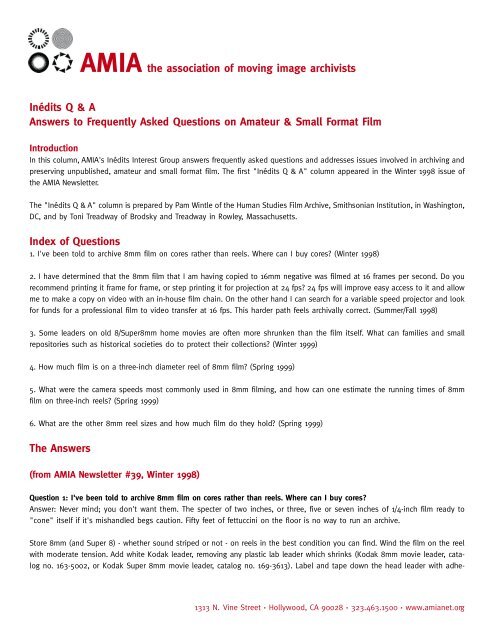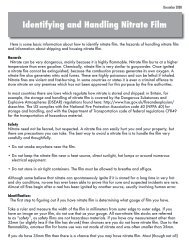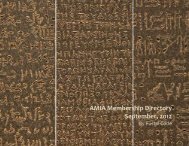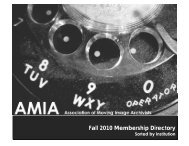Inédits Q&A - Questions on Amateur and Small Gauge Format Film
Inédits Q&A - Questions on Amateur and Small Gauge Format Film
Inédits Q&A - Questions on Amateur and Small Gauge Format Film
You also want an ePaper? Increase the reach of your titles
YUMPU automatically turns print PDFs into web optimized ePapers that Google loves.
AMIA the associati<strong>on</strong> of moving image archivists<br />
<str<strong>on</strong>g>Inédits</str<strong>on</strong>g> Q & A<br />
A n s wers to Frequently Asked <str<strong>on</strong>g>Questi<strong>on</strong>s</str<strong>on</strong>g> <strong>on</strong> <strong>Amateur</strong> & <strong>Small</strong> Fo rmat Fi l m<br />
In t ro d u c t i o n<br />
In this column, AMIA's <str<strong>on</strong>g>Inédits</str<strong>on</strong>g> In t e rest Group answers frequently asked questi<strong>on</strong>s <strong>and</strong> addresses issues invo l ved in archiving <strong>and</strong><br />
p reserving unpublished, amateur <strong>and</strong> small format film. The first "<str<strong>on</strong>g>Inédits</str<strong>on</strong>g> Q & A" column appeared in the Winter 1998 issue of<br />
the A M I A New s l e t t e r.<br />
The "<str<strong>on</strong>g>Inédits</str<strong>on</strong>g> Q & A" column is pre p a red by Pam Wintle of the Human Studies <strong>Film</strong> A rc h i ve, Smiths<strong>on</strong>ian Instituti<strong>on</strong>, in Wa s h i n g t o n ,<br />
DC, <strong>and</strong> by T<strong>on</strong>i Treadway of Brodsky <strong>and</strong> Treadway in Row l e y, Ma s s a c h u s e t t s .<br />
Index of Qu e s t i o n s<br />
1. I've been told to arc h i ve 8mm film <strong>on</strong> cores rather than reels. W h e re can I buy cores? (Winter 1998)<br />
2. I have determined that the 8mm film that I am having copied to 16mm negative was filmed at 16 frames per sec<strong>on</strong>d. Do yo u<br />
recommend printing it frame for frame, or step printing it for projecti<strong>on</strong> at 24 fps? 24 fps will improve easy access to it <strong>and</strong> allow<br />
me to make a copy <strong>on</strong> video with an in-house film chain. On the other h<strong>and</strong> I can search for a variable speed projector <strong>and</strong> look<br />
for funds for a professi<strong>on</strong>al film to video transfer at 16 fps. This harder path feels arc h i vally correct. (Su m m e r / Fall 1998)<br />
3. Some leaders <strong>on</strong> old 8/Super8mm home movies are often more shrunken than the film itself. What can families <strong>and</strong> small<br />
repositories such as historical societies do to protect their collecti<strong>on</strong>s? (Winter 1999)<br />
4. How much film is <strong>on</strong> a three-inch diameter reel of 8mm film? (Spring 1999)<br />
5. What we re the camera speeds most comm<strong>on</strong>ly used in 8mm filming, <strong>and</strong> how can <strong>on</strong>e estimate the running times of 8mm<br />
film <strong>on</strong> three-inch reels? (Spring 1999)<br />
6. What are the other 8mm reel sizes <strong>and</strong> how much film do they hold? (Spring 1999)<br />
The A n s we r s<br />
( f rom A M I A Newsletter #39, Winter 1998)<br />
Questi<strong>on</strong> 1: I've been told to arc h i ve 8mm film <strong>on</strong> cores rather than reels. W h e re can I buy core s ?<br />
A n s wer: Ne ver mind; you d<strong>on</strong>'t want them. The specter of two inches, or three, five or seven inches of 1/4-inch film ready to<br />
"c<strong>on</strong>e" itself if it's mish<strong>and</strong>led begs cauti<strong>on</strong>. Fifty feet of fettuccini <strong>on</strong> the floor is no way to run an arc h i ve .<br />
St o re 8mm (<strong>and</strong> Super 8) - whether sound striped or not - <strong>on</strong> reels in the best c<strong>on</strong>diti<strong>on</strong> you can find. Wind the film <strong>on</strong> the re e l<br />
with moderate tensi<strong>on</strong>. Add white Kodak leader, re m oving any plastic lab leader which shrinks (Kodak 8mm movie leader, catalog<br />
no. 163-5002, or Kodak Super 8mm movie leader, catalog no. 169-3613). Label <strong>and</strong> tape down the head leader with adhe-<br />
1313 N. Vine Street • Hollywood, CA 90028 • 323.463.1500 • www.amianet.org
AMIA the associati<strong>on</strong> of moving image archivists<br />
s i ve paper tape. Ne ver pull <strong>on</strong> the leader to tighten a too-loose wind of film or horiz<strong>on</strong>tal "cinch marks" (scratches) may occur<br />
a c ross the images. You may want to wrap the reel in acid-free tissue paper <strong>and</strong> shelve it in an arc h i val card b o a rd box. The boxe s<br />
for 1/4-inch audio tape are a good fit; see the Ga y l o rd catalog. Be sure to keep the original ye l l ow Kodak boxes, for they often<br />
hold dates, notes, <strong>and</strong> other clues about the c<strong>on</strong>tent; but be aware that in projecti<strong>on</strong> at family gatherings, boxes <strong>and</strong> reels are<br />
often mixed up. The ye l l ow boxes have become tre a s u red ic<strong>on</strong>s to many families because notes we re h<strong>and</strong>written by elders.<br />
( f rom A M I A Newsletter #41/42, Su m m e r / Fall 1998)<br />
Questi<strong>on</strong> 2: I have determined that the 8mm film that I am having copied to 16mm negative was filmed at 16 frames per sec<strong>on</strong>d.<br />
Do you recommend printing it frame for frame, or step printing it for projecti<strong>on</strong> at 24 fps? 24 fps will improve easy access<br />
to it <strong>and</strong> allow me to make a copy <strong>on</strong> video with an in-house film chain. On the other h<strong>and</strong> I can search for a va riable speed<br />
p rojector <strong>and</strong> look for funds for a professi<strong>on</strong>al film to video transfer at 16 fps. This harder path feels arc h i vally corre c t . "<br />
A n s wer: Make a pre s e r vati<strong>on</strong> copy frame for frame so that future re s e a rchers can have the simplest <strong>and</strong> best re p resentati<strong>on</strong> for<br />
their c<strong>on</strong>siderati<strong>on</strong>. Step printing to 24 fps re q u i res printing some frames twice which alters the re p resentati<strong>on</strong> of movement <strong>and</strong><br />
i n t roduces a slight stutter to some gestures. In t e r p reting step-printed movement can be a pro b l e m .<br />
Br a vo <strong>on</strong> ascertaining the frame rate for that is difficult with amateur film for several reas<strong>on</strong>s. Many camera models we re provided<br />
with a range of frame rates that could be imprecisely selected by moving a lever or turning a dial. To c<strong>on</strong>serve film, some<br />
filmmakers chose frame rates slower than the recommended 16 fps; sometimes 14 fps, often 12 fps. Fu r t h e r m o re, most amateur<br />
cameras prior to the 1950s we re powe red by spring-wound motors that sometimes moved film faster at the beginning of a shot<br />
than at the end. Often there is little or no documentati<strong>on</strong>, so the original filming rate has to be determined by repeated observati<strong>on</strong><br />
of certain incidental moti<strong>on</strong>s in the material, acti<strong>on</strong>s like walking, head turning, reaching, picking up a glass or cup. Si n c e<br />
this method is somewhat subjective, all the potential variables are best served by making the copy as close to the original as<br />
possible: frame for frame.<br />
It's a good choice to copy 8mm <strong>on</strong> to 16mm negative to help maintain quality c<strong>on</strong>trol because you are starting with an extre m e-<br />
ly high c<strong>on</strong>trast original, re versal film created for direct projecti<strong>on</strong>. A good technician can hold down c<strong>on</strong>trast build-up work i n g<br />
to the negative. 16mm prints from the negative increase access to exhibiti<strong>on</strong>. One cauti<strong>on</strong> when planning to screen films at original,<br />
n<strong>on</strong>-24 fps frame rates: you must work doubly hard before <strong>and</strong> during the screening with the technical people to be certain<br />
that they project at your film's original frame rate. We have all had the experience of running into the booth during the<br />
s c reening to request an adjustment to the frame rate to show the moti<strong>on</strong> in real time. For serious auditorium projecti<strong>on</strong> of framef<br />
o r-frame prints at the original frame rate, even an exhibitor with a small budget can find <strong>and</strong> re s t o re 16mm Bolex or Bell &<br />
Howell projectors which we re manufactured to do variable frame rates. 1000 watt lamps for them are still available. This equipment<br />
is an aff o rdable way to h<strong>on</strong>or the filmmaker <strong>and</strong> the people re c o rded <strong>on</strong> the film.<br />
( f rom A M I A Newsletter #43, Winter 1999)<br />
Questi<strong>on</strong> 3: Some leaders <strong>on</strong> old 8/Super8mm home movies are often more shrunken than the film itself. What can families <strong>and</strong><br />
small re p o s i t o ries such as historical societies do to protect their collecti<strong>on</strong>s?<br />
1313 N. Vine Street • Hollywood, CA 90028 • 323.463.1500 • www.amianet.org
AMIA the associati<strong>on</strong> of moving image archivists<br />
A n s wer: Leaders used <strong>on</strong> 8/S8mm films often shrink faster than the film because some labs <strong>and</strong> many amateur filmmakers<br />
attached plastic leaders which shrink more quickly over time than the triacetate base film itself. To be sure, replace all leaders<br />
with better material made from triacetate film stock such as Kodak's painted leaders (coated white). When assembling small ro l l s<br />
of 8/S8mm film into larger rolls or with larger reels which we re previously assembled be sure to check for <strong>and</strong> replace all the<br />
old leader including the leaders between the small rolls. (Old shrunken leader left between assembled rolls can cause damage<br />
when projecting or transferring the film.) Also, be sure to remember to splice the leader with the perforati<strong>on</strong>s in the same dire c-<br />
ti<strong>on</strong> as <strong>on</strong> the film itself <strong>and</strong> with base/emulsi<strong>on</strong> positi<strong>on</strong>s the same.<br />
If there is valuable informati<strong>on</strong> <strong>on</strong> the leader, re c o rd that informati<strong>on</strong> in materials documenting the film <strong>and</strong> save the leader as<br />
part of the arc h i val re c o rds, if desired. If the leader is of sentimental value, keep the leader but not attached to the film. Fa m i l i e s<br />
wanting to save the leaders will probably come up with some unique <strong>and</strong> cre a t i ve ways in which to display this form of family<br />
m e m o r a b i l i a .<br />
For projecti<strong>on</strong> purposes leaders should be approximately five feet - l<strong>on</strong>g enough to thread a projector with some extra left ove r<br />
because most damage occurs in the first few feet when a projector is started. Howe ve r, we are not recommending pro j e c t i n g<br />
these films; rather we are recognizing that many families c<strong>on</strong>tinue to do so. If the films are shrunken, they should not be projected.<br />
Shrunken film should be h<strong>and</strong>led with care <strong>and</strong> transferred to film or video for viewing purposes. (W h a t e ver its c<strong>on</strong>diti<strong>on</strong>,<br />
the original film should be kept <strong>and</strong> stored in as cool <strong>and</strong> dry a place as possible.) Leader needed for film-to-tape transfer<br />
or film-to-film copying can be as much as 6-15 feet but check with the video facility or laboratory for their re c o m m e n d a t i o n .<br />
Eastman Kodak still manufactures a good quality triacetate white painted 8/S8mm leader which can be ord e red from the Ko d a k<br />
Professi<strong>on</strong>al Moti<strong>on</strong> Imaging (PMI) order line at 800-621-3456. Unfortunately poor quality plastic leaders (both white <strong>and</strong> in va r-<br />
ious colors) are still available through some laboratories <strong>and</strong> vendors, sometimes at exorbitant rates. As always, it is best to<br />
make some comparis<strong>on</strong>s before purc h a s i n g .<br />
( f rom A M I A Newsletter # 44, Sp ring 1999)<br />
Questi<strong>on</strong> 4: How much film is <strong>on</strong> a three-inch diameter reel of 8mm film?<br />
A n s wer: If it's a full reel, 50 feet. T h ree-inch diameter 8mm reels originated as 25 foot double width 8mm camera loads to be<br />
exposed first in <strong>on</strong>e directi<strong>on</strong> then in the other - two rows of 8mm images running in opposite directi<strong>on</strong>s <strong>on</strong> a 16mm width film<br />
with twice the number of perforati<strong>on</strong>s as 16mm. The film was returned from processing split down the middle with the two 8mm<br />
secti<strong>on</strong>s spliced together as a 50 foot length of film <strong>on</strong> a three-inch re e l .<br />
An amateur filmmaker would purchase a box of unexposed film which came packed in a small black metal, plastic or aluminum<br />
can with black fricti<strong>on</strong> tape around it to keep it unexposed until use. The filmmaker re m oved the tape, opened the can <strong>and</strong><br />
found a daylight load roll of film with a paper wrapper around it bigger than the reel. The paper wrapper was re m oved <strong>and</strong><br />
s a ved in the can for later use for filmmaker identificati<strong>on</strong>. The film was threaded into the camera through the gate <strong>on</strong>to a take<br />
up reel already in the camera. After exposing 25 feet, the filmmaker had to re m ove the full take up reel, turn it over <strong>and</strong> re l o a d<br />
it into feed positi<strong>on</strong> to expose the other half of the film.<br />
This is the explanati<strong>on</strong> for light-struck flashes <strong>and</strong> splice in the middle of 50 feet of 8mm film. If a Kodak film we re <strong>on</strong>ly half<br />
exposed (run <strong>on</strong>ly in <strong>on</strong>e directi<strong>on</strong>), the tail bore perforati<strong>on</strong>s indicating the film type <strong>and</strong> the word "half-exp" for half exposed.<br />
1313 N. Vine Street • Hollywood, CA 90028 • 323.463.1500 • www.amianet.org
AMIA the associati<strong>on</strong> of moving image archivists<br />
When the other half of the film had been exposed, the end sticking out (the initial head of the reel) bore perforati<strong>on</strong>s indicating<br />
the film type <strong>and</strong> batch. After exposure the sec<strong>on</strong>d time through, the user filled in his name <strong>and</strong> postal address <strong>on</strong> the wrapping<br />
b<strong>and</strong>, wrapped the reel tightly, put the reel back into the can, re-sealed the can with the black tape, <strong>and</strong> gave the can to<br />
his/her photo dealer or mailed it off to be pro c e s s e d .<br />
T h e re we re a few excepti<strong>on</strong>s to the above. Some cameras used 8mm in 50 foot 8mm camera load cartridges. Also there we re<br />
some Bolex <strong>and</strong> Fa i rchild cameras that could load 100 <strong>and</strong> 200 feet of 8mm film. Fa i rchild's system was for an experimental sound<strong>on</strong>-film<br />
news gathering camera (8mm sound film appeared around 1960.) Fa i rchild's sound was re c o rded <strong>on</strong> magnetic (pre - s t r i p e d )<br />
8mm film in the camera 56 frames ahead of the corresp<strong>on</strong>ding picture. The camera was supposed to run at a fixed 24 fps, but<br />
experience has shown that the rate varied down to less than 20 fps as the batteries ran down or from some other pro b l e m .<br />
Questi<strong>on</strong> 5: What we re the camera speeds most comm<strong>on</strong>ly used in 8mm filming, <strong>and</strong> how can <strong>on</strong>e estimate the running times<br />
of 8mm film <strong>on</strong> three-inch re e l s ?<br />
A n s wer: T h e re are 80 frames per foot <strong>on</strong> "regular" or "st<strong>and</strong>ard" 8mm film. A quick formula to determine 8mm running time is<br />
as follows: 80 frames per foot times 50 feet divided by frame rate equals running time in sec<strong>on</strong>ds of <strong>on</strong>e three-inch reel. Di v i d e<br />
the sec<strong>on</strong>ds by 60 to get minutes.<br />
He re are some running times for 8mm at diff e rent camera frame rates:<br />
• 16 fps: The most comm<strong>on</strong> 8mm frame rate is 16 fps. 50 feet of 8mm at 16 fps is 4 minutes 17 sec<strong>on</strong>ds.<br />
• 12 fps: The sec<strong>on</strong>d most comm<strong>on</strong> 8mm frame rate is 12 fps. 50 feet of 8mm at 12 fps is 5 minutes 34 sec<strong>on</strong>ds.<br />
• 24 fps: This speed tended to be used for "professi<strong>on</strong>al" applicati<strong>on</strong>s, by train buffs or others filming moving subjects such<br />
as sports or dance, or by serious hobbyists for titling, animati<strong>on</strong> or films which we re to be optically printed to 16mm. 50 feet<br />
of 8mm at 24 fps is about 167 sec<strong>on</strong>ds or 2 min. 47 sec<strong>on</strong>ds, which is approximately equal to 100 feet of 16mm at 24 fps.<br />
• 18 fps: During the early 1960s an 18 fps marking began to appear <strong>on</strong> some 8mm cameras <strong>and</strong> amateurs began to use it.<br />
It is virtually impossible to ascertain the frame rate in a viewe r. Most older 8mm projectors are variable speed which is useful<br />
for determining the frame rate.<br />
C AUTION: Only use a projector which is known to be clean <strong>and</strong> in top notch running c<strong>on</strong>diti<strong>on</strong> with film known to be in good,<br />
n<strong>on</strong>-shrunken c<strong>on</strong>diti<strong>on</strong> under close supervisi<strong>on</strong>. Dual format 8mm/Super8mm projectors have designated frame rates. Some projectors<br />
have 9, 18 <strong>and</strong> 24 fps rates marked, which is a help in judging the correct fps rate. Some projectors have a capstan rather<br />
than a sprocket drive, which is easier <strong>on</strong> film.<br />
Questi<strong>on</strong> 6: What are the other 8mm reel sizes <strong>and</strong> how much film do they hold?<br />
A n s wer: In many 8mm collecti<strong>on</strong>s you will find:<br />
• A six-inch diameter reel, which is 300 feet<br />
• A s e ven-inch diameter reel, which is 400 feet<br />
• If the reel if full to ove r f l owing, add an additi<strong>on</strong>al 50 feet <strong>and</strong> be very careful in h<strong>and</strong>ling to avoid spilling the film.<br />
1313 N. Vine Street • Hollywood, CA 90028 • 323.463.1500 • www.amianet.org






